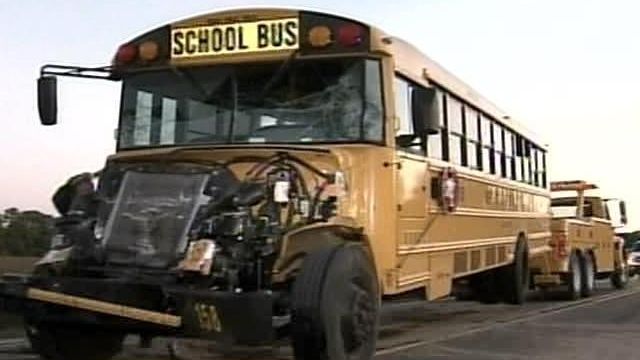Fight Predicted for School Bus Seat Belt Money
Installing seat belts on school buses could create a funding fight among North Carolina school districts and law enforcement agencies.
Posted — UpdatedU.S. Transportation Secretary Mary Peters on Monday announced proposed federal regulations that would mandate three-point seat belts – lap and shoulder restraints – be phased in on all new smaller buses nationwide within three years from when the regulation is adopted.
A standard would be created for seat belts on larger buses, but Peters said states and individual school districts would decide whether to have them installed in new buses.
Schools could use federal highway safety money to offset the cost of adding seat belts, which amounts to about $10,000 per bus, Peters said.
North Carolina receives about $10 million to $12 million in federal highway safety funds, said Darrell Jernigan, director of the Governor's Highway Safety Program. The money is used for programs like Click It or Ticket to promote seat belt usage and also to support local law enforcement agencies and their traffic safety campaigns, he said.
State officials estimated it would cost about $8.6 million per year to phase in seat belts on new large school buses.
Jernigan said that adding school bus seat belts to the list of competing requests for the highway safety money would likely create a fight statewide over the limited allocation.
The state does not pay for smaller buses under 10,000 pounds that will soon be required to have lap and shoulder belts. Child-care facilities and YMCAs most commonly use those buses, but local school districts sometimes buy them to use as activity buses.
Some parents and officials said school bus seat belts should be a priority.
"I think it's worth it. This should've been done a long time ago," said Kimberly Brewer, a former school bus driver whose eighth-grade daughter was injured in a Nov. 7 bus wreck near Selma.
One school bus rear-ended another bus on the 1500 block of N.C. Highway 96 near Selma. Sixty-five students from Selma Middle School and Selma Elementary School were on the two buses at the time of the wreck, and 26 of them had to be taken to nearby hospitals with an assortment of injuries.
Students would have suffered fewer and less serious injuries in the wreck if the two buses had been equipped with seat belts, Brewer said.
"I think we shouldn't wait until something serious happens," she said. "Children (are) our precious cargo, and I don't understand why we don't have that."
California, Florida, Louisiana, New Jersey and New York require seat belts on school buses, although Louisiana hasn't yet funded its program.
North Carolina has been studying the effectiveness of the restraints for four years and has equipped 14 buses statewide with three-point belts. The state already fulfills a second federal recommendation – raising the height of seat backs to 24 inches.
"I really think parents expect belts on buses," said Derek Graham, chief of the Transportation Services Section in the North Carolina Department of Public Instruction, adding that bus drivers like seat belts because they help with discipline.
"A fatality on a school bus is an extremely rare event, and more often than not, it involves a catastrophe – a bus crashing off an overpass, being hit by a snow plow, being hit by a train," Graham said.
School buses are considered among the safest forms of transportation because of their size, visibility and existing safety features like reinforced sides and padded, high-back seats that are placed close together.
Since 1990, 16 North Carolina students have been killed in accidents involving school buses. Only three of those deaths occurred when students were in the school bus. A gravel truck ran into a school bus in Mecklenburg County in 1991, killing two 12-year-olds and a 13-year-old.
The 13 other deaths happened when students were hit by school buses or other vehicles.
Between 2004 and 2006, 819 students were injured in school bus accidents, with the total declining each year during that period. There were 3,317 accidents involving school buses statewide over the three years.
More than 12 percent of the state's school bus accidents took place in Wake County in 2005. That rate was surpassed only by Mecklenburg County – then the largest school system in the state – with 20.5 percent of the accidents. Durham County came in third, with 5.8 percent.
Guilford and Forsyth were the only other counties to claim more than 3 percent of the state's school bus accidents.
About 750,000 students ride school buses to and from school in North Carolina every day.
A crash in Alabama last year in which four teens died after their school bus plunged over an overpass rekindled the seat belt debate that led to Peters' Monday announcement of the proposed federal standard.
State Sen. Jim Forrester, R-Gaston, wants to avoid such incidents in North Carolina and is pushing a bill that to require seat belts in buses statewide.
"I think it's worth it. It's a safety issue," Forrester said. "If you take and put it in seat belts, you're taking from somewhere else. I realize that because there's only a limited amount of money. But I think it's money well spent for the safety of the children in our state."
Wayne Stowe, whose 5-year-old daughter was injured in the Selma bus collision, said he doesn't think seat belts in buses are worth the cost.
"I don't think really it's necessary," Stowe said. "I just think this (accident) is a fluke."
• Credits
Copyright 2024 by Capitol Broadcasting Company. All rights reserved. This material may not be published, broadcast, rewritten or redistributed.





